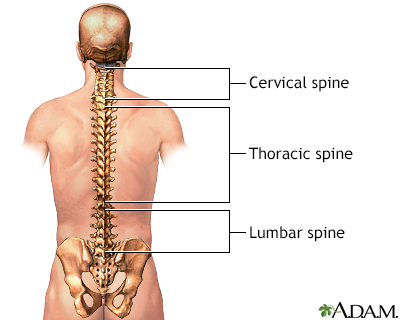
X-ray - lumbosacral spine; X-ray - lower spine
A lumbosacral spine x-ray is a picture of the bones (vertebrae) in the lower part of the spine. This area includes the lumbar region and the sacrum, the area that connects the spine to the pelvis.






The test is done in a hospital x-ray department or your health care provider's office by an x-ray technician. You will be asked to lie on the x-ray table in different positions. You may be asked to lean forward in flexion or lean back and extend your back. If the x-ray is being done to diagnose an injury, care will be taken to prevent further injury.
The x-ray machine will be placed over the lower part of your spine. You will be asked to hold your breath as the picture is taken so that the image will not be blurry. In most cases, 3 to 5 pictures are taken.
Tell your provider if you are pregnant. Take off all jewelry.
There is rarely any discomfort when having an x-ray, although the table may be cold.
Often, your provider will treat a person with low back pain for 4 to 8 weeks before ordering an x-ray.
The most common reason for lumbosacral spine x-ray is to look for the cause of low back pain that:
Lumbosacral spine x-rays may show:
Though some of these findings may be seen on an x-ray, they are not always the cause of back pain.
Many problems in the spine cannot be diagnosed using a lumbosacral x-ray, including:
There is low radiation exposure. X-ray machines are checked often to make sure they are as safe as possible. Most experts feel that the risk is low compared with the benefits.
Pregnant women should not be exposed to radiation, if at all possible. Care should be taken before children receive x-rays.
There are some back problems that an x-ray will not find. That is because they involve the muscles, nerves, and other soft tissues. A lumbosacral spine CT or lumbosacral spine MRI are better options for soft tissue problems.
Contreras F, Perez J, Jose J. Imaging overview. In: Miller MD, Thompson SR, eds. DeLee, Drez, & Miller's Orthopaedic Sports Medicine. 5th ed. Philadelphia, PA: Elsevier; 2020:chap 7.
Kapoor G, Toms AP. Current status of imaging of the musculoskeletal system. In: Adam A, Dixon AK, Gillard JH, Schaefer-Prokop CM, eds. Grainger & Allison's Diagnostic Radiology. 7th ed. Philadelphia, PA: Elsevier Limited; 2021:chap 38.
Parizel PM, Van Thielen T, van den Hauwe L, Van Goethem JW. Degenerative disease of the spine. In: Adam A, Dixon AK, Gillard JH, Schaefer-Prokop CM, eds. Grainger & Allison's Diagnostic Radiology. 7th ed. Philadelphia, PA: Elsevier Limited; 2021:chap 48.
Warner WC, Sawyer JR. Scoliosis and kyphosis. In: Azar FM, Beaty JH, eds. Campbell's Operative Orthopaedics. 14th ed. Philadelphia, PA: Elsevier; 2021:chap 44.
BACK TO TOPReview Date: 4/1/2025
Reviewed By: Jason Levy, MD, FSIR, Northside Radiology Associates, Atlanta, GA. Also reviewed by David C. Dugdale, MD, Medical Director, Brenda Conaway, Editorial Director, and the A.D.A.M. Editorial team.

|
A.D.A.M., Inc. is accredited by URAC, also known as the American Accreditation HealthCare Commission (www.urac.org). URAC's accreditation program is an independent audit to verify that A.D.A.M. follows rigorous standards of quality and accountability. A.D.A.M. is among the first to achieve this important distinction for online health information and services. Learn more about A.D.A.M.'s editorial policy, editorial process and privacy policy. A.D.A.M. is also a founding member of Hi-Ethics and subscribes to the principles of the Health on the Net Foundation (www.hon.ch). |
The information provided herein should not be used during any medical emergency or for the diagnosis or treatment of any medical condition. A licensed medical professional should be consulted for diagnosis and treatment of any and all medical conditions. Call 911 for all medical emergencies. Links to other sites are provided for information only -- they do not constitute endorsements of those other sites. © 1997- A.D.A.M., Inc. Any duplication or distribution of the information contained herein is strictly prohibited.